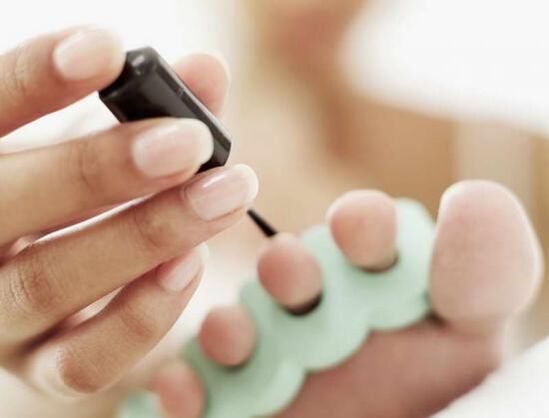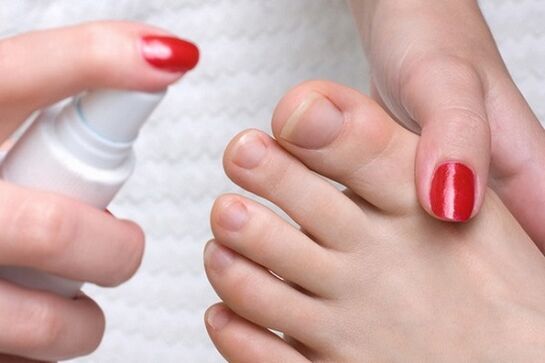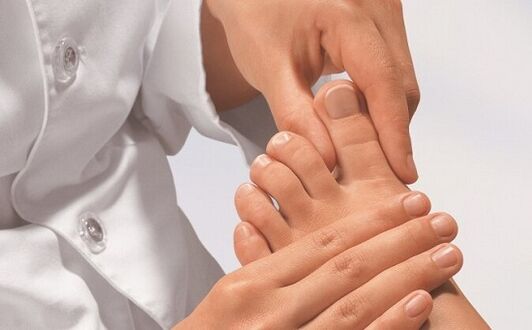
Nail fungus (lat. Onychomycosis) - in other words - a fungal infection of the nails. The disease can affect both the fingernails and toenails. The reason is mainly so-called dermatophytes, less often fungi of the Candida species (yeasts) or molds.
Color changes, thickening and brittleness of the nails are symptoms of fungi, but also of other diseases of the skin and nails, therefore, if such changes are found, it is necessary to contact a dermatologist and also do bacteriological tests for the presence of fungi such as sowing .
It is estimated that about 50% of people whose nails on the palms and feet are rough and discolored suffer from nail fungus.
Causes and symptoms of nail fungus
Nail fungus usually appears after foot fungus infection. According to studies, up to 42% of people suffer from foot fungus and 21% of people suffer from nail fungus. More often men suffer from it (except candidiasis), rarely children, but very often the elderly. This disease affects all races equally.
Most often in temperate climates, fungal nail infections are caused by dermatophytes, i. e. Trichophyton rubrum (70% of nail fungus cases), Trichophyton mentagrophytes (20% of all nail fungus cases), Trichophyton interdigitale, Epidermophyton floccosum , Trichophyton tonshophyton violaceum, Microsporum gypseum soudanense and Trichophyton verrucosum. In the world there are more and more cases of infection by fungi of other varieties, with the exception of dermatophytes and yeasts, or Fusarium spp. , Scopulariopsis brevicaulis, Aspergillus spp. In some countries, Aspergillus spp. it is the cause of up to 15% of fungal cases.
You can be infected with a fungus, for example:
- in the swimming pool,
- in the sauna,
- putting on someone else's shoes or putting on someone else's socks,
- using someone else's manicure devices.
- The fungus often appears between the fingers.
What is nail fungus?
Fungi that have already appeared on the skin of the feet can penetrate the skin and nail if the nail is damaged. It could be a wound or a nail that's cut too short. Nail diseases tend to affect weakened nails, and the use of nail polishes and false nails in particular contributes to weakening.
Also, some patients are predisposed to this type of infection due to various diseases they have. One of these are immunosuppressive disorders (immunosuppressive states) associated with, for example, HIV infection or chronic treatment with immunosuppressive drugs after organ transplantation or some autoimmune diseases.
Another group of problems associated with an increased risk of nail fungus are hormonal disorders (Cushing's disease or syndrome, hypothyroidism and others). This disease is more common in the presence of metabolic diseases, for example diabetes, which is a disease that contributes to various infections, not just fungal.
The fungus is more common in obese people with anemia (anemia), circulatory system disorders that cause nail plate ischemia, and in patients with gastrointestinal disorders.
Nail fungus often affects patients who are treated with chemotherapy for malignant tumors who take antibiotics (especially not accompanied by probiotics), as well as patients who, for various reasons, take steroid drugs known for their immunosuppressive effects, that is, by disrupting the functioning of the immune system.
There are four main types of nail fungus, regardless of which part of the nail is affected. The most common type of fungus affects the far (distal) part of the nail, including the supra-nail plate, i. e. the skin located in front, under the nail plate.
Symptoms of nail fungus

Interestingly, nail fungus may initially be asymptomatic; in these cases, only increased fragility and slight discoloration of the nail plate occurs. Only after a while, characteristic and pronounced changes in the appearance of the nail begin to appear.
Symptoms of nail fungus are, first of all, changes in the nails, especially at the initial stage of the development of the disease. The first changes usually appear on the free (front) edge of the nail plate or on the sides.
With the further development of nail fungus, further problems may arise with physical activity (for example, exercise) and also when walking and standing. Then patients complain of paresthesia (numbness), pain, discomfort, loss of physical fitness. Characteristic changes within the nails during the course of the fungus include:
- color changes: nails become white, yellow, brown, greenish,
- peeling and peeling of the nail plate, markedly increased fragility,
- undulation of the nail plates,
- thickening of the nail plate, a symptom of excessive keratinization,
- unpleasant smell of feet.
The fungus can present with various symptoms. Two different patients infected with the same type of fungus can experience different nail changes.
Toe nail fungus can be quite distinctive in character. It can be called from the so-called. mold fungi. This form of fungus is often found in the elderly and is associated with impaired blood supply to the nail (trophic disorders). The nail plates of the thumbs thicken, deform, acquire a greenish-yellow tint, and a significant thickening of the epidermis is observed under the plates. As a rule, nail fungus lasts for many years without treatment. Unfortunately, even with proper and long-term treatment, this disease can recur.
The above symptoms are usually determined by the fungus. In addition to the characteristic appearance of the nails, the detection of a fungus of the skin of the feet and hands, which usually accompanies a fungal infection of the nails, can help in the diagnosis of the nail fungus. However, the diagnosis is not always obvious.
In some cases, it is also necessary to perform laboratory tests. The doctor takes a sample and examines it under a microscope. Another auxiliary analysis in the diagnosis of nail fungus is the culture of the fungi taken. Thanks to this, it is possible to determine the type and verify the sensitivity to specific drugs.
If the doctor suspects nail fungus in a given patient, they should also consider other conditions that could have a similar picture, namely:
- nail psoriasis - it may look similar, however, the characteristic difference of this disease is that it often affects all nails, symmetrically; in addition, psoriasis is usually accompanied by typical skin changes;
- thrush (or candidiasis) of the nails is another type of nail fungus, in contrast to the classic one, associated with dermatophyte infection; it is characterized by the appearance of purulent secretions from under the nail crests and pain;
- trophic changes caused by a violation of the blood supply to the nail plate; they usually begin in the proximal part of the plate (i. e. at its base);
- lichen planus is a disease in which the appearance of papules (changes) on the skin and mucous membranes is characteristic, the simultaneous presence of which, as a rule, simply allows you to distinguish lichen from a fungus; the nail plate with lichen has a characteristic longitudinal undulation.
When pressed, purulent contents are displayed. If the candida changes do not disappear for a long time, the nail plates turn gray-yellow-brown, lose their luster, are rough and exfoliate.
Candidiasis of the nail plates and rollers must be distinguished from panaritium, that is a bacterial infection, which differs first of all in that it is limited to a single finger and proceeds more acutely, with greater pain. Also, candidiasis can be confused with "common" nail fungus and nail psoriasis.
To make a definitive diagnosis of thrush, it is necessary to do a culture (culture of the Candida fungus). It is impossible to recognize mushrooms of this family in direct preparation, i. e. examining secretions taken from a sore spot, without culture.
At the conclusion of the discussion of the symptoms of nail fungus, it is worth recalling the psychological problems that patients suffering from this disease may encounter. These include decreased self-esteem and worsening social contacts. These problems can mainly affect those who have nail fungus.
Methods for the treatment of nail fungus

Nail fungus treatment is a must. Lack of treatment for nail fungus leads to a chronic and progressive course of the disease. There can be no spontaneous healing. Therefore, always in case of the appearance of suspicious changes in the area of the nails on the palms or feet, it is necessary to make an appointment with a dermatologist.
Even if it turns out that the cause of the disorder is not a fungal infection, only a dermatologist will be able to determine which disease the patient is suffering from.
Unfortunately, the treatment of the disease under discussion is difficult and not always effective. This is because the frustrated patient simply stops using the prescribed medication. In order for the course of treatment to be effective, its duration should be several months, even after the symptoms disappear.
In the initial stages of the fungus, when the changes on the nails are still insignificant, a fungicidal ointment will suffice. When the fungus is started, as a rule, oral agents are used. Relapses of the fungus are quite frequent, therefore, after recovery, you should follow the recommendations of a dermatologist and take care of foot hygiene. Many patients refuse treatment soon after the symptoms disappear, and this is wrong, as it can lead to a relapse and the need to restart treatment.
Home treatment for nail fungus is usually ineffective.
Changes in the nails should be examined by a dermatologist. What you can do on your own to promote therapy is to maintain foot hygiene, wash and dry your feet thoroughly, do not cut your nails too short, and do not use manicure equipment, towels, socks and shoes. other people.
In general, nail fungus treatment depends on the type of infection, the clinical type of the disease, the number of infected nails, and the degree of damage to the plaques. In some cases, systemic treatment through oral agents is required. Sometimes local treatment is enough, that is, ointments, creams. Undoubtedly, the combination of systemic and local treatment improves the success rates of nail fungus therapy. Unfortunately, even with the use of the latest medications, the rate of nail fungus recurrence remains high. In the future, photodynamic and laser therapy could find application in the treatment of this disease.
Effective drugs for the treatment of nail fungus
Local remedies without oral medications should be used only in cases where the lesion occupies less than half of the distal (far) part of the nail plate and also when the patient does not tolerate systemic treatment well. These are rare cases: as a rule, local treatment, unfortunately, is not enough.
As a rule, local remedies used as the only therapy for nail fungus are not able to completely cure it, as they do not penetrate deep enough into the plaque.
True, it was believed that the solutions penetrate all layers of the nail, but they remained ineffective when used alone (as the only medicine). However, these drugs can be used as "adjuvant" therapy, in addition to an oral agent, or as a prophylaxis for relapses in patients who have previously treated nail fungus with systemic (oral) agents.
Medicines for the treatment of nail fungus
Oral treatment for nail fungus cases is almost always needed. The new generation of oral antifungal drugs have recently replaced previous generations in the treatment of nail fungus. The effectiveness of the new agents lies in their ability to penetrate deeply into the nail plate within a few days of starting treatment.
Through their use it is possible to allow a reduction in the duration of therapy, obtaining a greater percentage of recovery and fewer side effects.
In case of therapy by these means, patients should arm themselves with patience and calmly wait for a healthy nail to grow back after the completion of the treatment. This may take longer.
Nail fungus removal
Removal of fungus-affected nails is also considered a solution. For nail fungus, surgical treatment can be used. Here we are talking about the mechanical or chemical removal of the infected nail plate. Chemical removal of the plate is possible using a 40-50% urea solution. This is a painless and effective method in cases where the nail is very thick.
Removal of the nail plate should be considered as an adjunct treatment for patients on oral therapy. The combination of oral and local treatment (lubrication) and surgery offers a higher cure rate and at the same time is the most effective and economical option (minimal relapses, short-term treatment).
When treating nail fungus, it is not necessary to limit activities in a broad sense, but it is recommended to avoid places where contamination can occur, such as public swimming pools.















